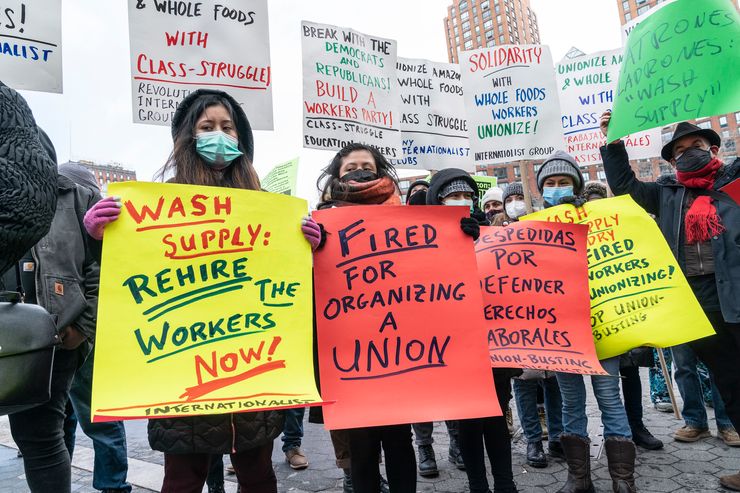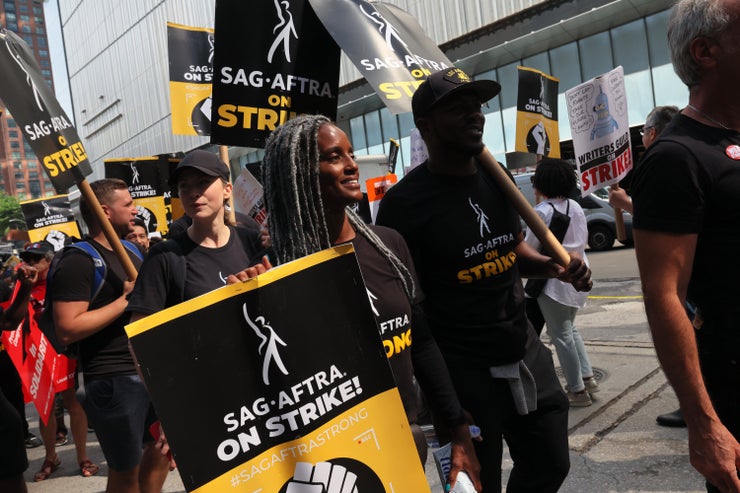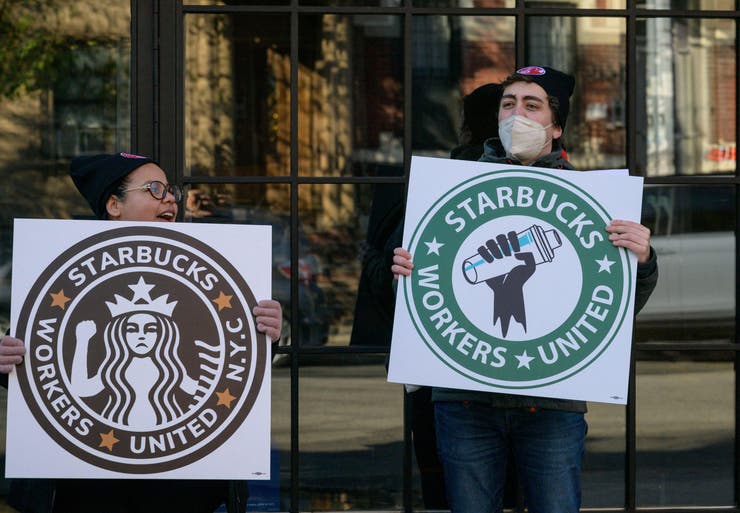Are labor unions making a comeback? I hope I’m not speaking out of turn when I say, “I hope so.”
I say “out of turn” because unions have spent much of the last four decades suffering from declining membership while falling out of favor with the public. Of late, however, there is a sense that the state of the unions is getting stronger.
Aggressive worker movements nationwide and a recent string of successful settlements — driving wages higher than in decades — have energized workers to take more direct action. From Apple and Amazon to Chipotle and Starbucks, union drives have been in high gear at some of America’s biggest companies.
A recent Bloomberg News headline warned, “Wells Fargo Privately Worries Union ‘Resurgence’ Could Reach Its Workers Next,” with a subheading that read: “Bank leaders fret over a ‘new generation’ of union successes.”
I have a hard time feeling any sympathy for big banks, given their role in the Great Recession of 2008, but I also have a hard time feeling any sympathy for the big companies and corporate behemoths that now dominate economies both domestically and globally.
According to Wells Fargo’s research, this union renaissance is a bona fide nationwide trend. One slide in a PowerPoint presentation for the bank executives noted, “Employers are facing a significant resurgence in union organizing with election petitions increasing by nearly 60% in 2022.”
Who’s Kidding Who
What the suits at Wells Fargo are fretting over is that its employees will unionize, after which they’ll have to pay those workers what they’re actually worth. What a concept.
I’ve never understood why so many became so hostile toward labor unions when they have contributed so much to our nation’s shared prosperity and robust middle class.
I mean, of course, private sector unions, not public ones. Those are very different animals with very different challenges. But having grown up in New York, a union town, if ever there was one, my support for unions is pretty much in my DNA.
To be sure, unions aren’t perfect, and unions and their various locals can vary. I’ll bet you a steak dinner that someone reading this has a story about their union protecting a lame employee who would have otherwise been bounced were it not for the union protecting him. Others will note how their union works to turn a shoddy worker into a better employee or else see them to other employment, even if it means going back to school to improve a worker’s employability. And still others will argue that no, at their shop, you can get fired for “lack of production.” After all, who wants to work with an electrician who keeps burning things down?
Throughout the history of workers’ rights, labor unions have fought to provide members with better pay, benefits and working conditions. And though protecting a bad employee can tarnish the image of labor unions, that seems a small price to pay to protect good employees from the power of large and, at times, unscrupulous employers trying to take unfair advantage of their workers.
In fact, studies repeatedly show that in fields where union rates were high, non-union members enjoyed better wages and benefits. Treating workers well helped management avert the threat of union organizing. In a way, unions created their own form of trickle-down economics.
With all the power and resources corporations have at their disposal, unions help level the playing field between employees and management. Many reforms that unions implemented decades ago have been codified into law.
Consider that in 1900, less than 10% of American workers were unionized. America’s wealthiest 10% earned 40% of all national income, which widened to nearly 50% in the 1920s. But in 1935, the New Deal era granted workers basic collective bargaining rights. Union membership grew to more than 35% of the workforce, while the upper 10% share of salaried income fell to less than 35%. The result after World War II was a 30-year period of unparalleled prosperity in the United States and the healthiest middle class in the world.
It would be hard to argue that such prosperity would have happened had it not been for organized labor.

Unions In Decline
Why, then, did unions fall out of favor?
You can lay the blame in a lot of places, and a lot of scholars have.
- The recession of the 1970s and the concurring Japanese encroachment on two lynchpins of the American economy: steel and automobiles. As often happens in a recession, the high unemployment resulted in a reserve workforce that employers could use to replace striking workers.
- The greed of rapacious corporate raiders in the 1980s with their hostile takeovers, dismembering healthy companies, destroying jobs and communities.
- Employers in the 1970s began to take full advantage of labor laws passed by Republicans in the 1940s and ‘50s to effectively weaken workers’ bargaining power.
- Technological advances such as automation and digitization allow companies to restructure and turn large, older facilities into smaller, nimbler operations, increasing worker productivity but done with fewer workers.
- Employers increasingly outsourcing union jobs, decreasing membership, thereby.
- Former President Ronald Reagan, that’s all.
All these factors (and others) contributed to union declines, but Reagan may have delivered the harshest blow. In firing over 11,000 air traffic controllers — what some have called the most disastrous strike in American history — Reagan flipped the narrative: Strikers suddenly were no longer sympathetic workers but selfish lawbreakers hurting regular Americans. Reagan, meanwhile, looked like the hero protecting the public.
Beyond the stuff of legend, that firing became widely disseminated in academia, and business leaders started getting tougher with unions. Strikebreaking became a thing: copper miners, paper workers, meatpackers, bus drivers, one strike after another broke, and many of those workers were fired. In some cases, employers wanted their employees to strike so they could fire them and replace them with non-union workers. The strike, a union’s biggest piece of leverage, practically vanished.
The number of strikes in 1981: 140.
Today: 10-20.
Union membership suddenly seemed a pointless exercise. Why seek union representation when you can still lose your job? Some workers even began voting to end their union representation. Unions weakened, lawmakers became less dependent on their support and the political incentive to back pro-union legislation faded.
The other thing that began to fade: A thriving middle class.
The Growing Income Gap
Government figures show the median full-time salary in 1980 was $46,889 when adjusted for inflation. In 2010, it was $47,715. During that same period, income for the top 1% of earning households grew 275%.
Simultaneously, private sector union membership fell from its peak of nearly 40% of working Americans to just 7%, roughly where it was in 1928.
And the income disparity has continued unabated, sometimes with seemingly heartless cruelty. A 2010 study found that CEOs of the 50 firms that laid off the most workers since the start of the 2008 recession took home 42% more pay in 2009 than their peers at S&P 500 firms.
Average CEO pay in 2021 was 324 times that of median worker earnings. Last year, it was 272 times larger, primarily due to poor stock returns. Oh, those poor dears. Yet companies tend to respond to such downturns by resorting to mass layoffs. For example, Disney and Warner Bros. have cut thousands of jobs in recent months.
Think about that. You make 300 times more than your median worker, but when your financial worth takes a dip over a Wall Street hiccup, you fire the worker making 300 times less than you. And someone wants to beef about unions protecting an incompetent worker?
In Hollywood, while TV and film writers are striking to protect and even save their jobs, the eight studio heads are making a combined $850 million annually. Warner Brothers CEO David Zaslav made $498,915,318 between 2018 and 2022, a staggering 384 times the average pay of a Hollywood writer.
It begs the question: How much money is enough money? Participants of a recent Bankrate survey said they’d need an annual salary of roughly $230,000 to feel financially secure. That’s over three times the annual median U.S. household income of about $71,000
With apologies to Gordon Gekko, I just do not see how greed is all that good.

A Renaissance
But the times may be a-changin’. Aggressive unionizing efforts are popping up like whac-a-moles, sparked by economic pressures like high inflation, rising interest rates, a tight labor market and the newest digital threat of artificial intelligence.
In the past few months, unions have negotiated deals with United Airlines, United Parcel Service (UPS), and The New York Times.
A strike by UPS workers would have been the largest against a single employer in U.S. history and would have shaken the U.S. economy. Just a 10-day walkout could have resulted in losses totaling $7 billion.
The pro-union push seems more like an avalanche. Workers organizing has been growing at a geometric rate, as have requests for the National Labor Relations Board to hold union elections. Workers are increasingly filing petitions with management to address employee grievances.
Since December 2021, when the first Starbucks successfully voted to unionize, 340 Starbucks locations have done the same, representing some 8,500 baristas. Workers at 100 more locations have filed for elections to do the same.
The International Brotherhood of Teamsters — yeah, those guys — whose members include 340,000 UPS workers, have made unionizing Amazon a top priority.
While the Hollywood writer’s strike remains at a stalemate (it’s the first double strike of SAG-AFTRA and the Writers Guild of America in 63 years), the studios may have been feeling some pressure when they took the unusual step of publicly releasing some details of their most recent proposal.

What’s encouraging in all this is that unions are popular. You wouldn’t think that given how far union membership had fallen since the Reagan years, but Gallup, which has tracked public opinion of unions since 1936, finds that seven in 10 Americans now approve of labor unions, a figure that hasn’t been seen since 1965. Pew Research finds that most adults think the decline in union membership is bad for the country and its workers. Roughly 70% of non-union workers would support a union if given the opportunity, part of what scholars call a “representation gap” — the gap between the percentage of employees who desire union representation and those who have it.
“That calculates out to 58 million more members,” according to research by Thomas Anton Kochan, a professor of industrial relations, work, and employment at the Massachusetts Institute of Technology Sloan School of Management, “But unions only reach less than 0.01% of the non-union workforce in organizing,” he told me in an email, a paltry percentage given a national workforce of 164 million people.
How is that possible? In the last 30 months, we’ve seen strikes, pickets, protests, a cascade of union victories and public support for labor unions at an all-time high, yet actual membership remains at an all-time low. Why?
Causes Of Decline
“Part of the fault is on the labor movement,” Kate Bronfenbrenner, a professor at Cornell University’s School of Industrial and Labor Relations, told Axios. “They’re organizing the same way they always have.”
Kochan said, “They need to organize in more innovative ways organizing at the company level, not store by store or warehouse by warehouse or factory by factory.”
In other words, the modern labor movement of the 20th century needs a reboot to become the modern labor movement of this century.
That might mean tapping into a younger generation. One recent poll found that among all generations, union support was highest among Gen Z, defined as being 23 years old or younger in 2020. That’s due partly to its racial and ethnic diversity and a non-judgmental attitude about class, ideology and gender. They also share high levels of financial anxiety as they enter the workforce during growing economic uncertainty. Their college degrees no longer promise the job security and economic stability of generations before them. Those are precisely the sorts of conditions that attracted millions of workers to join unions decades ago.
The bigger problem, however, is that the labor law system in America is broken. Corporations effectively control it.
“The penalties for employer violations of labor law are ludicrous,” Kochan said, “so weak that it has no deterrent effect.”
As Kochan’s colleague Anna Stansbury has written, the result is that U.S. firms have no incentive to comply with the Fair Labor Standards Act, which guarantees the federal minimum wage and overtime, and the National Labor Relations Act, which guarantees the right to organize.
Anti-union sentiment began “after the labor movement failed to get a Democratic Congress and President to pass a modest labor law reform bill in 1978,” Kochan said. “They couldn’t get one more vote needed to break the filibuster. After that, companies became more open about their union avoidance strategies.”
Reagan’s firing of the traffic controllers and his subsequent appointing of minions to the National Labor Relations Board (to minimize their clout for enforcement) accelerated the anti-union push. The rest, as they say, is history.
Some companies will do anything, and have, to stop workers from unionizing. Reports of retaliation are widespread. But if they want to rid themselves of unions, there’s a better way.
The Eastman Kodak Business Model
Eastman Kodak was a photo industry giant in the 20th century, employing thousands of workers. In Rochester, New York, its corporate headquarters, one in eight employed persons in the region worked for Kodak. But despite unionizing efforts, employees never unionized. Company founder George Eastman developed a model of what has been called welfare capitalism to take care of his employees. These included the Kodak Welfare Fund to assist employees no longer able to work because of accident, illness or retirement. A “Wage Dividend”— an innovation for its time — provided employees with yearly dividends on the company stock. Eastman began doing this in the company’s early years, around 1910. In 1919, he gave one-third of his own holdings of company stock — then worth $10 million — to his employees as a gift.
It was a simple philosophy, really. Unlike corporations today that see virtually no difference between their employees and a socket wrench, Eastman understood that he wasn’t just managing employees; he was managing human beings. It was an obligation he felt toward them. He created one of the world’s most loyal workforces because he was loyal. Success was as much about worker goodwill as the company’s inventions and patents, which were many and revolutionary in their day. Workers felt, why do we need a union when this company treats us so well?
Do any companies out there wanna give the Eastman corporate model a shot?
Unions As Necessity
Why do we need unions? Because they’re necessary. Unions are necessary so long as industries have their own associations. So long as industry management and owners lobby for their interests, unions will be necessary. Do you like the Chamber of Commerce? Then you should love unions, as well. Do you like industry think tanks? Then you should like unions, as well. Do you like business lobbying? Then you should like union lobbying. If you want to abolish unions, you need to prevent industry leaders from meeting.
Does anyone think that sort of imbalance is a sensible component of a healthy working society?
So long as corporations lobby and meet with one another to plan their strategies, we should need unions to look out for the workers’ interests and plan their strategies. It would be nice if we didn’t have to do that. If we had responsible management modeled after the values of George Eastman, there would be no need for unions, but we don’t have that. Instead, we have a culture steeped in the idea of increasing shareholder value and excusing executives when they gorge on a hefty chunk of that value for themselves and then point to the workers as if they were to blame. Contracts to pay management in the millions are fine, even if it eats into profits, but if you use some of the money from those parachute packages to pay thousands of workers a little bit more per hour, all of a sudden, that’s socialism?
The wisdom goes, if you want the best workers, you gotta pay for it. That seems to be the wisdom in looking at executive packages, but when it comes to paying the workers, the folks at ground level who actually produce the products, whose labor the entire business is dependent upon, then that’s somehow stealing from the shareholder value.
Management, government, labor. That three-legged stool is out of balance now, but if the scope and breadth of union activism inspire other workers to follow suit, future historians might look upon 2023, what Professor Kochan calls the year of labor’s discontent, “as the dawn of a new social contract fitted to today’s workforce, technologies, and economy.”
There is a lot at stake, but the potential is great.

